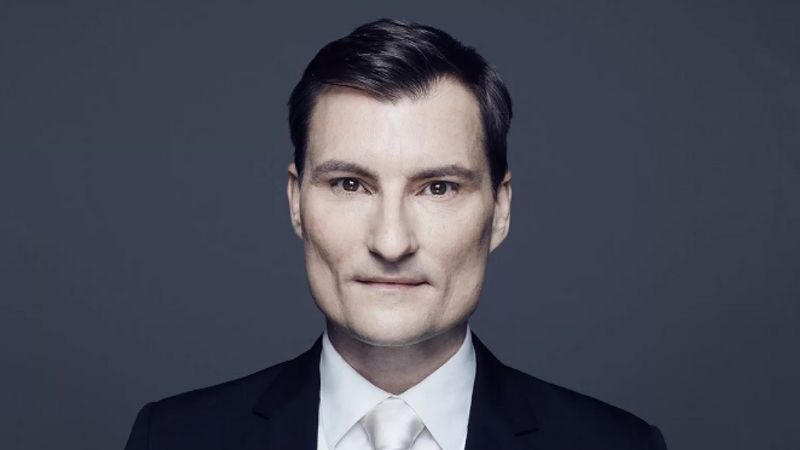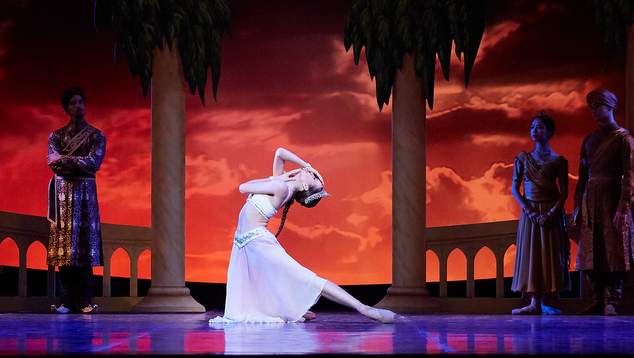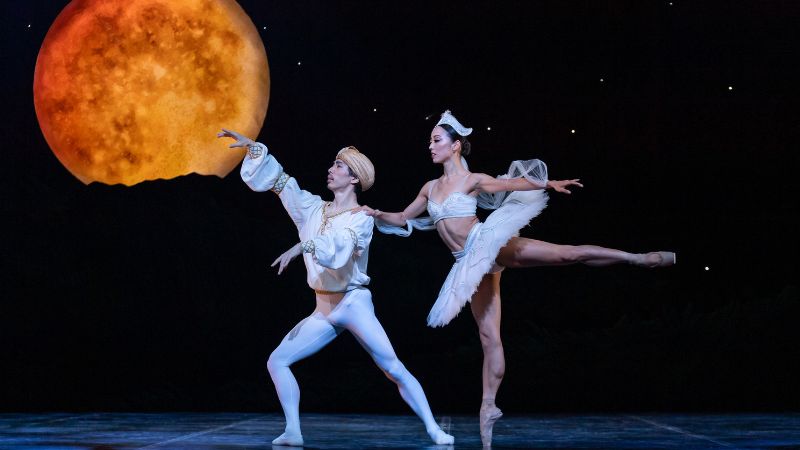David McAllister grew up in Perth in the 1960s and 1970s before heading out into the world to become one of Australia’s most acclaimed ballet dancers, and then on to be a respected choreographer and artistic director.
He’s worked with many of the biggest names in the world of dance and spent two decades leading The Australian Ballet.
This year’s he’s back in Perth, spending a year as the Guest Artistic Director of the West Australian Ballet while the company searches the world for its next creative leader.

The season of ballet that McAllister is presenting at the West Australian Ballet features the company’s traditional season of modern dance outdoors at The Quarry, plus fairytale of Sleeping Beauty, and contemporary dance showcase State, staged at the State Theatre.
There’s also a romantic production of Romeo and Juliet, and Genesis, where company members get to build their choreographic skills. None will likely create as many column inches as their current show, a restaging of La Bayadère: The Temple Dancer.
An international group opposed to stagings of the 19th century classical work have raised concern about the production, although they admit they’ve never seen this particular production which was created by celebrated Australian choreographer Greg Horseman.
Horseman worked with members of the Indian communities on adapting the work, placing it in a specific historical setting, adjusting the music to incorporate traditional scales and instruments, and not proceeding before he had a thumbs up from cultural advisors.
Whenever a company stages La Bayadère it seems the company, its funding bodies and sponsors will hear from the US based Rajan Zed, President of the Universal Society of Hinduism.
The call to ban the work has not been echoed locally, but it has sparked discussion in artistic circles about cultural appropriation, casting choices and how to update works for modern sensibilities. At ArtsHub, Jo Pickup provides a nuanced assessment.

OUTinPerth’s co-editor Graeme Watson chatted to David McAllister about ballet controversies, how the artform is improving its ability to recruit boys into its ranks, writing an autobiography and his own journey with sexuality and acceptance.
Grame’s own working life began in the world of dance, and he spent hundreds of hours of his youth perfecting pirouettes, chassés, pas de chat and grand jetes.
When the West Australian Ballet staged the same production of La Bayadère in 2019 there wasn’t the same level of concern about its content, does it feel like something has significantly changed in the world?
I think we are all much more aware of cultural appropriation, and I think diversity of the public experience of these 19th century classics.
I think Greg Horseman was a bit of ahead of the curve with that, with this production. Back in 2018 when he choreographed it, we did it here in 2019, he really saw the possibilities of eliminating some of that quasi-oriental Hindu sort of rhetoric and really making it about the tension between the British and the Indians during that period of the Raj.
To me, that made it a much more compelling production and a much more interesting dialogue about the human relationships, between that sort of conflict, and that sort of conflict continues all around the world.
I recall the 2019 production here in Perth, to me it seemed to be more of a commentary on British colonialism than any of the accusations that have been raised by overseas activists.
It did make me think about how ballet has been an artform that adjusts stories and settings constantly to give new context works.
I agree. Would we then take all those beautiful paintings off the walls in art galleries around the world? A lot of different cultures were represented in a fairly, not demeaning, but a very sort of artificial way.
I think it’s a bit like Gone with the Wind, I think it’s really great to have that sort of precursor at the beginning, saying when this was filmed, attitudes were different. It’s still a great work of art, you just have to view it through the context of when it was made.
I think ballet has been good really throughout the ages. People always talk about the traditional ballets, but actually, all of those traditional ballets have been messed around and manipulated to speak to a contemporary audience in their various times.

With this version of La Bayadère Greg has done that, quite honestly. The original production of La Bayadère was very 19th century racist, it’s like people blacking up and really a very scared, or little or no understanding of the culture that they were setting the ballet in.
I think there are some people that seem to just have a Google alert, the minute La Bayadère pops up they’re ready to go. I do think that that’s fair enough, because with a traditional production there are things that needed to be addressed. This production sits in that latter portfolio of productions that have looked through the lens of a more contemporary society.
Ballet is a world where there’s often five works on repetition: The Nutcracker, Swan Lake, Coppelia, Les Sylphides, Giselle and repeat.
West Australia Ballet have had great success creating new works like Dracula, but also staging lesser-known works like La Bayadère. What is it that makes this ballet special?
Absolutely it’s the second act. The Kingdom of the Shades is one of those iconically ballet-blanc scenes. Women in white tutus, really mesmeric sort of music, and ballet in that state of talking about fantasy.
They are the dead spirits of these bayaderes who come down from the Himalayan Mountains to, not haunt, but commune with the living. Solor there in his opium induced state, experiencing these otherworldly beings. It’s very 19th century ballet at its almost sort of romantic. And it’s,
It’s a beautiful piece of choreographic work, it’s an essay of beauty in that sort of form of the 19th century ballet. A lot of companies do it out of context, because it is just such a beautiful piece. You can actually take it out and just do that bit. I think that’s the reason La Bayadère survives.
Much in the same way there’s the garden scene of Le Corsaire, all of those 19th century classics had that beautiful white ballet scene where the women were in tutus, they were usually white or pink or maybe pale blue.
It’s an incredible feat for a corps de ballet of women to do that and look so calm and exquisite. While they’re doing very difficult steps on a 40 odd degree angle on a ramp, it’s quite an amazing feat of endurance, and ability, and technique.
How are you finding your year leading the West Australian Ballet?
It’s been a delight, I’ve got to say, from the very beginning, and it’s so nice to be home.
I’ve spent way too long away from Perth, and it’s just so nice to come back and to see the company. So developed and, and as you say, they’re doing such interesting work.
The company has always been great, but I just feel like there’s been this uptick of local support and great talent coming into the company. It’s a great pleasure to be here. I feel like I’m having a great time.
West Australian Ballet has grown a lot in the last few years, but ballet companies have changed significantly since you started your career, how has ballet as an industry changed?
When I first joined, my first job was in 1983, since then the companies have first of all become much more commercialised. Ballet companies used to be run like a tennis club. Now it’s very professional organisation.
There’s a lot of rigor around the way that we run the company, but also the way we look after our dancers, and I think the health and wellness of dancers is one of the biggest changes. It’s led to dancers now having careers into their 40s, where we used to be a bit like AFL teams, by the time you hit 30, if you were still dancing, you were a dinosaur.
Now dancers have much more longevity, they have much healthier post-dance lives, and we’re working on it being a much more inclusive, and a healthy mental environment as well. So that the dancers not only have great strength, but they also have a great sense of themselves and their wellbeing.
I think that’s a huge change because it was for a very long time ‘just shut up and dance’, but I think it’s making for a much more healthy, much more interesting, ultimately a happier place.
Ballet companies, I’ve always found to be incredibly supportive, but sometimes there was that sense of hierarchy. Everyone had to not be seen and not heard. I think that just doesn’t work in this generation. We have a very different generation of dancers and their expectations of how they work is very different.
You’ve written your autobiography, which was a joy to read. Some of my favourite ballet teachers are in there. I had Mark Annear and Lucette Aldous as lecturers at WAAPA, and Kelvin Coe was at a ballet camp I went to when I was eleven.
It made me recall arriving at WAAPA and for the first time there was another boy in the class. Another boy who could dance. Before that it was largely just me and a lot of girls. Are we getting more boys interested in ballet now?
I taught a class a couple of weeks ago, organised by the West Australian Classical Ballet Teacher’s Association, and there were about 16 boys in that class, which was really heartening.
From little six-and seven-year-olds, through to teenagers. I asked some of the parents and teachers afterwards “How is it for guys now?” And they were like, “Oh, no, their friends are very supportive, and they’re not hiding their ballet shoes in their sports bag anymore.”
I think it’s the Billy Elliot factor, the fact that fathers, and parents now are probably a little bit more informed about what a career in dance can be. I think these kids they’re not being discouraged to actually take it on.
We’re very lucky, there’s a great pipeline of talent coming through. The boys in the class, I was like, “Wow!, there’s really some future dancers in this group.” I think it’s very healthy, we’ve just got to continue to build that sense.
You shared in your book that choosing to follow your passion in dance did lead to you hearing a lot of homophobic slurs and moments of homophobia. In your experience how did that play with your sexuality?
For me, I spent a lot of my youth with people directing homophobic slurs at me, telling me I was gay because I was a dancer, which stopped me from acknowledging that I was gay. I think that’s quite common in the dance world.
That was very much my experience. I think because it was used as such a negative slur, that I was determined not to be. I didn’t want to be that sort of monster that people expressing.
I guess through the years, I mean, I went through the ballet company as a you know, as a teenager and early 20-year-old at a time when also there was the HIV epidemic. It was really quite scary to be an out gay person.
I think it did affect my relationship with my sexuality, but I think that also keyed up into the fact that I was brought up Catholic.
I did have great affection for the women that I worked with, and had a couple of relationships with, but ultimately, yeah, I think it did take me a longer, a much longer time to actually work out where I sat in the sexuality spectrum.
But having said that, I don’t think that kids have that now. Younger people today, think of sexuality as like, ‘wow, whatever’. The whole gender politics is whatever, be what you want to be. They’re so much more permissive than when you and I were younger people.
David McAllister’s autobiography Soar, A Life Freed by Dance is available now. La Bayadere: The Temple Dancer plays at His Majesty’s Theatre until 20th April.
Take a look at the full program for the West Australian Ballet.






